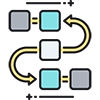CPM vs PERT

Differences Between CPM vs PERT
CPM and PERT are two sides of the same coin. Both are sophisticated tools you can use in project management.
They will help you effectively plan, analyze, and schedule your projects. But they have their unique differences, too.
Read on and discover the differences between CPM and PERT. Plus, also see the advantages of each tool over the other.
CPM vs PERT
You can differentiate between CPM vs PERT based on their focus, nature, orientation, time estimation, and more. Let’s look more closely at each of these factors.
Main Focus
 CPM, or Critical Path Method, focuses on cost optimization. This helps you increase productivity and cut the overall cost of your project.
CPM, or Critical Path Method, focuses on cost optimization. This helps you increase productivity and cut the overall cost of your project.
PERT, or Program Evaluation Review Technique, focuses on time control. This helps minimize the time duration to complete your project.
Nature of Technique
CPM is used to balance project costs and timelines effectively. It’s a great tool to plan, schedule, and analyze well-defined activities.
PERT is used to plan and control the timeline of projects. Unlike CPM, PERT is a tool to plan, schedule, and analyze uncertain activities.
Orientation
CPM is activity-oriented. What we mean is that in CPM, a network is constructed on the basis of each activity. What’s more, the time factor is known in CPM.
On the other hand, PERT is event-oriented. In this, a network is constructed on the basis of events. Additionally, the time factor is unknown in PERT.
Type of Model
CPM follows a deterministic model. In simpler words, it does not take into account the uncertainties involved while estimating the time duration of an activity.
PERT follows a probabilistic model. It takes certain uncertainties into account while estimating the time duration of an activity.
Time Estimation
You can use CPM for reasonable time estimation. That’s because there is only a single time estimate in CPM, based on the longest sequence of tasks.
PERT, on the other hand, is great if you want a high precision time estimation. Unlike CPM, there are three time estimates in PERT: optimistic time, most likely time, and pessimistic time.
Suitability
CPM is suitable for non-research based activities. It’s a great tool to manage construction, defense, software, and aerospace projects.
You can use PERT for R&D related projects. These include complex manufacturing and assembling projects.
Advantages of CPM Over PERT
 In certain cases, using CPM over PERT can be beneficial. It will help you cut costs, handle various types of projects, and provide greater flexibility.
In certain cases, using CPM over PERT can be beneficial. It will help you cut costs, handle various types of projects, and provide greater flexibility.
Here are some advantages of CPM vs PERT.
- CPM gives more importance to cost-cutting as compared to PERT. So, you can use it to plan and schedule a project on a tight budget.
- You can use CPM to handle large, small, as well as medium-sized projects. But PERT can only be used for large projects and is not suitable for small and repetitive works.
- CPM is flexible whereas PERT is time-bound. That means while using PERT, various problems can arise if a project is not completed on time.
Advantages of PERT Over CPM
There are also times when using PERT over CPM can be advantageous. You will be able to meet your targets on time, handle complex projects more effectively, and improve coordination between different departments.
Take a look at some advantages of using PERT over CPM.
- Looking for greater time precision? Use PERT instead of CPM, as it takes into account three different time estimates.
- For large and complex projects, use PERT. The tool is more sophisticated than CPM and will offer greater clarity.
- Resource allocation and coordination between different departments are better in PERT as compared to CPM.
CPM vs PERT – In a Nutshell
CPM vs PERT both help you achieve the same scheduling goals. But they have different approaches.
CPM focuses on cost-cutting whereas PERT focuses on time control. This fundamental difference creates other differences in their orientation, nature, suitability, and more.
Both tools have their advantages and disadvantages, too. So, it’s better to have an in-depth knowledge of both CPM and PERT before picking the one that works the best for your project.
Project Management Tools – Additional Resources
- Trello – Trello helps teams move work forward.
- Asana – Work on big ideas, without the busywork.
- Kissflow Project – Track less, work more. Manage your projects your way!
- Wrike – Remove barriers, find clarity, exceed goals
- Zoho Projects – Cloud-based project management software, helps you plan your projects, track work efficiently, and collaborate with your team, wherever they are.
